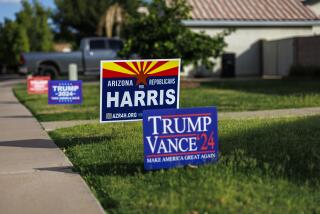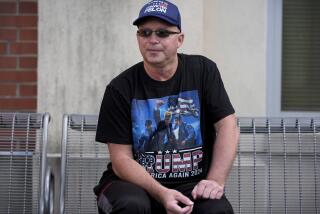Good Ol’ Boy Hoping for Bumper Harvest in Iowa
- Share via
SPENCER, Iowa — Some of the 140 people who filed into the Spencer Public Library to hear Sen. John Edwards speak the other day might not have known it, but they were a test for Mark Becker, an 18-year-old high school senior here in rural northwestern Iowa.
Becker, a precinct captain for the North Carolina senator, began knocking on undecided voters’ doors two weeks ago, urging them to attend Wednesday’s midday talk, a dry run of his efforts to get at least eight Edwards supporters out for Monday’s caucuses. Becker recognized “five or six” of those undecided voters in the audience, a harbinger, he hoped, of the future.
“I actually talked them into coming,” said Becker, who skipped part of the school day to listen to Edwards -- and to monitor the turnout.
Becker is a foot soldier in Edwards’ strategy for finishing well in next week’s caucuses. While other leading candidates are focusing on urban areas, where unions and established political organizations are primed to pack the caucuses, Edwards -- running as an outsider -- is looking to the countryside.
From the beginning, he has played the rural card, skipping over the part of his life story where he became a millionaire and spent five years in the U.S. Senate, to present himself as the local boy-done-good, the millworker’s son who knows what it’s like to unload trucks in the North Carolina summer, and who can be the champion of the common man.
So the campaign has mounted something of an agrarian insurrection. When Edwards comes to Iowa, he holds an event in whatever city he flies into, then makes a beeline for the countryside. Before the new year, he talked to voters by the dozens in living rooms and diners. Now he speaks to hundreds in American Legion halls, local libraries and schools.
It’s a strategy that hinges as much on math as on message.
Each of Iowa’s 1,993 precincts will select some of the state Democratic delegates up for grabs. The allotment for each precinct is based on a numerical average of the Democrats who voted in the 2000 presidential and 2002 gubernatorial elections. Urban areas will select more delegates than those in rural, Republican-heavy areas. However, because fewer Democrats live in rural precincts, a candidate can scoop up delegates more easily.
Edwards hopes to harvest enough delegates in precincts like Becker’s to offset expected strong showings by Howard Dean, Dick Gephardt and John F. Kerry in urban areas, where the game is played on a larger and more complex scale, and where union support -- Edwards has virtually none -- can steer the course of a caucus.
“It can be a very effective strategy,” said David P. Redlawsk, a political science professor at the University of Iowa in Iowa City and co-chair of the Johnson County Democratic Party. “The numbers you have to get out aren’t as great.”
Redlawsk, who remains undecided, said his precinct in Iowa City could draw as many as 300 people on caucus night, while “in the outlying areas where the Edwards people are focusing, you have precincts with 20 people.”
Mark Daley, a spokesman for the state Democratic Party, said a rural strategy, combined with a solid campaign in the urban areas, could be a successful formula. Indeed, Gephardt used it to win the Iowa caucuses in 1988.
But it’s impossible in this 2004 race, Daley said, to gauge which of the leading candidates has the best organization in rural areas. “They all have a considerable number of staff all over the state,” he said.
Like Edwards, Dean has visited all 99 of Iowa’s counties, and has the help now of Iowa Sen. Tom Harkin’s organization. Gephardt, a popular U.S. representative from neighboring Missouri, also has his own network in place.
“That’s the unknown here for the Edwards people -- to what degree are Gephardt’s folks competing on the same soil?” Redlawsk said.
Edwards has crafted a prescription for healing dying towns -- a mix of programs aimed at adding jobs and improving education and health-care systems. But few voters who attend his campaign events in rural areas ask about his ideas.
Instead, they press him on the broader issues of the economy and health care, the war in Iraq and his own electability.
Jay Schaben, an uncommitted voter who runs a livestock auction house in Dunlap, in western Iowa, said he has met most of the other Democratic candidates and likes Edwards. But not enough to commit. “He seems fresh,” Schaben said. But “Gephardt probably understands more about the agricultural world than anybody else.”
In Spencer, the Edwards campaign -- based on an analysis of past caucuses -- expects about 50 people to attend the caucus in Becker’s precinct, which means at least eight Edwards supporters must be present at the start of the meeting to be “viable” -- passing a threshold of 15% of those in attendance. Backers of candidates with less than 15% support either go home or switch to another candidate.
Becker and Edwards’ campaign officials believe that with the candidate’s emphasis on rural issues -- and his standing as a top second choice for many supporters of other hopefuls -- that he can do well in places like Spencer. Becker said he expected Gephardt to win Clay County, where Spencer is located, but he expected Edwards to pick up some delegates too.
“We’re not fighting for first,” said Becker, who has been spending his evenings knocking on the doors of Democrats and independents in his neighborhood. “If we get third, we’re going to be on the gravy train.”
Edwards has spent heavily on television ads -- $1.3 million -- in the Des Moines and Cedar Rapids markets, which cover a wide swath of rural central Iowa, while buying less time in industrial Davenport and no airtime in Omaha, which broadcasts to heavily Republican rural western Iowa.
Evan Tracey, whose media research firm is tracking political advertising in the 2004 campaign, said the key difference between Edwards and the other candidates on ad buys is that Edwards has been spending at a consistent pace since late summer, while the rest have kicked up their spending in the last couple of weeks.
“It’s almost like he’s taking it as more of a marathon, while Gephardt and Kerry have kind of poured a lot in late,” Tracey said.
Edwards has not written off the urban areas. In early December, his campaign began trying to build a network of precinct captains by dividing the state into 14 districts, each responsible for scouring the rolls of active Democrats to find people to lead the charge in the neighborhood meetings on Monday night.
The Des Moines war room, which covers 10 urban and rural counties in the central part of the state, is a former auto-parts shop tucked between an adult bookstore and a diner with a Bush-Cheney sign propped defiantly in a window facing the headquarters. Inside, the room has the ramshackle feel of college life, the whitewashed walls covered with Edwards posters and hand-drawn signs, including the chant “1, 2, 3, 4, who ya gonna caucus for?” painted on a sheet.
From late afternoon through the evening, a shifting number of volunteers makes phone calls to former caucus-goers urging them to support Edwards, and asking those who already do to sign up as precinct captains. Every time a new captain is found, a schoolmarm’s bell is rung.
These days, the bell doesn’t ring much. The reason: Most of the precincts are covered, said Rob Berntsen, Edwards’ Iowa caucus director.
More to Read
Get the L.A. Times Politics newsletter
Deeply reported insights into legislation, politics and policy from Sacramento, Washington and beyond. In your inbox twice per week.
You may occasionally receive promotional content from the Los Angeles Times.











